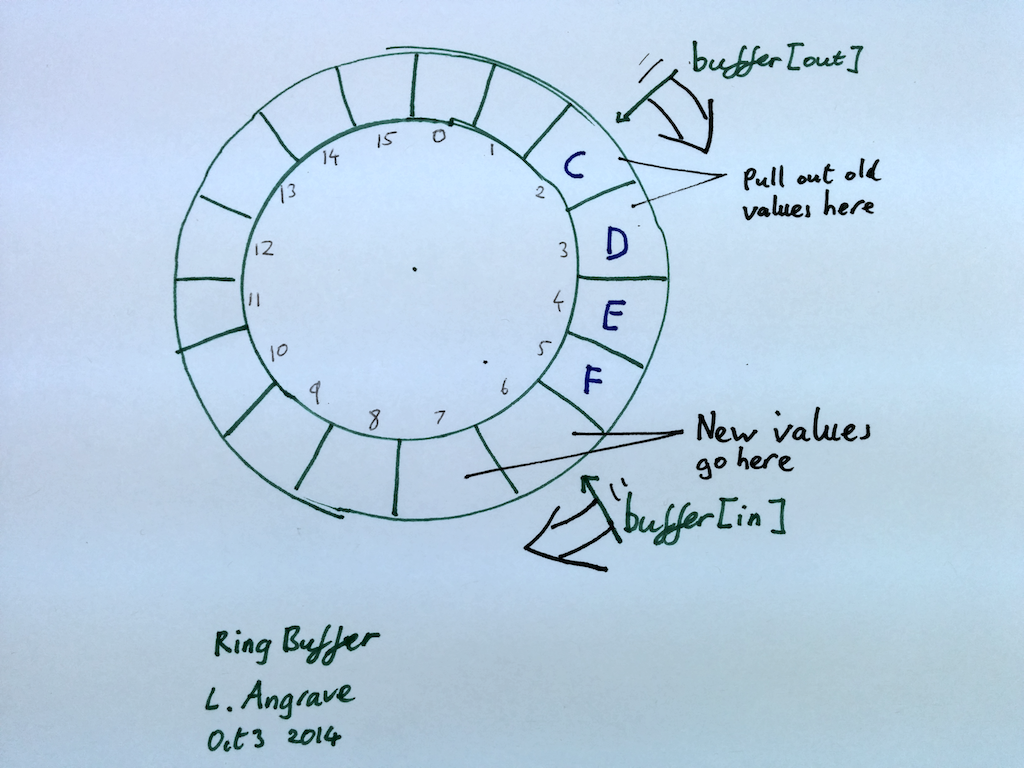# 同步,第 8 部分:環形緩沖區示例
> 原文:<https://github.com/angrave/SystemProgramming/wiki/Synchronization%2C-Part-8%3A-Ring-Buffer-Example>
## 什么是環形緩沖區?
環形緩沖區是一種簡單的,通常是固定大小的存儲機制,其中連續內存被視為圓形,兩個索引計數器跟蹤隊列的當前開始和結束。由于數組索引不是循環的,因此當移過數組末尾時,索引計數器必須回繞到零。當數據被添加(入隊)到隊列的前面或從隊列的尾部移除(出隊)時,緩沖區中的當前項形成一條似乎環繞軌道的列車一個簡單的(單線程)實現如下所示。注意 enqueue 和 dequeue 不會防止下溢或溢出 - 當隊列已滿時可以添加項目,并且當隊列為空時可以刪除項目。例如,如果我們將 20 個整數(1,2,3 ...)添加到隊列中并且沒有使任何項目出列,則值`17,18,19,20`將覆蓋`1,2,3,4`。我們現在不會解決這個問題,相反,當我們創建多線程版本時,我們將確保在環形緩沖區滿或空時分別阻塞入隊和出隊線程。
```c
void *buffer[16];
int in = 0, out = 0;
void enqueue(void *value) { /* Add one item to the front of the queue*/
buffer[in] = value;
in++; /* Advance the index for next time */
if (in == 16) in = 0; /* Wrap around! */
}
void *dequeue() { /* Remove one item to the end of the queue.*/
void *result = buffer[out];
out++;
if (out == 16) out = 0;
return result;
}
```
## 實現環形緩沖區有什么問題?
以下面的緊湊形式編寫入隊或出隊方法非常誘人(N 是緩沖區的容量,例如 16):
```c
void enqueue(void *value)
b[ (in++) % N ] = value;
}
```
這種方法似乎有效(通過簡單的測試等),但包含一個微妙的 bug。有足夠的入隊操作(超過 20 億),`in`的 int 值將溢出并變為負值!模數(或“余數”)運算符`%`保留符號。因此,您最終可能會寫入`b[-14]`!
緊湊的形式是正確的使用位屏蔽,只要 N 是 2 ^ x(16,32,64,...)
```c
b[ (in++) & (N-1) ] = value;
```
此緩沖區尚未阻止緩沖區下溢或溢出。為此,我們將轉向我們的多線程嘗試,它將阻塞線程,直到有空間或至少有一個項目要刪除。
## 檢查多線程實現的正確性(示例 1)
以下代碼是不正確的實現。會發生什么? `enqueue`和/或`dequeue`會阻塞嗎?相互排斥是否滿足?緩沖區可以下溢嗎?緩沖區可以溢出嗎?為清楚起見,`pthread_mutex`縮短為`p_m`,我們假設 sem_wait 不能被中斷。
```c
#define N 16
void *b[N]
int in = 0, out = 0
p_m_t lock
sem_t s1,s2
void init() {
p_m_init(&lock, NULL)
sem_init(&s1, 0, 16)
sem_init(&s2, 0, 0)
}
enqueue(void *value) {
p_m_lock(&lock)
// Hint: Wait while zero. Decrement and return
sem_wait( &s1 )
b[ (in++) & (N-1) ] = value
// Hint: Increment. Will wake up a waiting thread
sem_post(&s1)
p_m_unlock(&lock)
}
void *dequeue(){
p_m_lock(&lock)
sem_wait(&s2)
void *result = b[(out++) & (N-1) ]
sem_post(&s2)
p_m_unlock(&lock)
return result
}
```
## 分析
在閱讀之前,看看你能找到多少錯誤。然后確定如果線程調用 enqueue 和 dequeue 方法會發生什么。
* enqueue 方法在同一個信號量(s1)上等待和發布,類似于 equeue 和(s2),即我們遞減值然后立即遞增值,所以在函數結束時信號量值不變!
* s1 的初始值為 16,因此信號量永遠不會減少到零 - 如果環形緩沖區已滿,則 enqueue 不會阻塞 - 因此溢出是可能的。
* s2 的初始值為零,因此對 dequeue 的調用將始終阻塞并且永不返回!
* 需要交換互斥鎖和 sem_wait 的順序(但是這個例子很破壞,這個 bug 沒有效果!)##檢查多線程實現的正確性(例 1)
The following code is an incorrect implementation. What will happen? Will `enqueue` and/or `dequeue` block? Is mutual exclusion satisfied? Can the buffer underflow? Can the buffer overflow? For clarity `pthread_mutex` is shortened to `p_m` and we assume sem_wait cannot be interrupted.
```c
void *b[16]
int in = 0, out = 0
p_m_t lock
sem_t s1, s2
void init() {
sem_init(&s1,0,16)
sem_init(&s2,0,0)
}
enqueue(void *value){
sem_wait(&s2)
p_m_lock(&lock)
b[ (in++) & (N-1) ] = value
p_m_unlock(&lock)
sem_post(&s1)
}
void *dequeue(){
sem_wait(&s1)
p_m_lock(&lock)
void *result = b[(out++) & 15]
p_m_unlock(&lock)
sem_post(&s2)
return result;
}
```
### 分析
* s2 的初始值為 0.因此,即使緩沖區為空,enqueue 也會在第一次調用 sem_wait 時阻塞!
* s1 的初始值為 16.因此即使緩沖區為空,dequeue 也不會在第一次調用 sem_wait 時阻塞 - oops 下溢! dequeue 方法將返回無效數據。
* 該代碼不滿足互斥;兩個線程可以同時修改`in`或`out`!該代碼似乎使用互斥鎖。不幸的是鎖從未用`pthread_mutex_init()`或`PTHREAD_MUTEX_INITIALIZER`初始化 - 所以鎖可能不起作用(`pthread_mutex_lock`可能什么都不做)
## 正確實現環形緩沖區
偽代碼(`pthread_mutex`縮短為`p_m`等)如下所示。
由于互斥鎖存儲在全局(靜態)內存中,因此可以使用`PTHREAD_MUTEX_INITIALIZER`進行初始化。如果我們為堆上的互斥鎖分配了空間,那么我們就會使用`pthread_mutex_init(ptr, NULL)`
```c
#include <pthread.h>
#include <semaphore.h>
// N must be 2^i
#define N (16)
void *b[N]
int in = 0, out = 0
p_m_t lock = PTHREAD_MUTEX_INITIALIZER
sem_t countsem, spacesem
void init() {
sem_init(&countsem, 0, 0)
sem_init(&spacesem, 0, 16)
}
```
入隊方法如下所示。注意:
* 鎖定僅在關鍵部分(訪問數據結構)期間保持。
* 由于 POSIX 信號,完整的實現需要防止`sem_wait`的早期返回。
```c
enqueue(void *value){
// wait if there is no space left:
sem_wait( &spacesem )
p_m_lock(&lock)
b[ (in++) & (N-1) ] = value
p_m_unlock(&lock)
// increment the count of the number of items
sem_post(&countsem)
}
```
`dequeue`實現如下所示。請注意同步調用`enqueue`的對稱性。在這兩種情況下,如果空格計數或項目數為零,則函數首先等待。
```c
void *dequeue(){
// Wait if there are no items in the buffer
sem_wait(&countsem)
p_m_lock(&lock)
void *result = b[(out++) & (N-1)]
p_m_unlock(&lock)
// Increment the count of the number of spaces
sem_post(&spacesem)
return result
}
```
## 值得深思
* 如果交換`pthread_mutex_unlock`和`sem_post`調用的順序會發生什么?
* 如果交換`sem_wait`和`pthread_mutex_lock`調用的順序會發生什么?
- UIUC CS241 系統編程中文講義
- 0. 簡介
- #Informal 詞匯表
- #Piazza:何時以及如何尋求幫助
- 編程技巧,第 1 部分
- 系統編程短篇小說和歌曲
- 1.學習 C
- C 編程,第 1 部分:簡介
- C 編程,第 2 部分:文本輸入和輸出
- C 編程,第 3 部分:常見問題
- C 編程,第 4 部分:字符串和結構
- C 編程,第 5 部分:調試
- C 編程,復習題
- 2.進程
- 進程,第 1 部分:簡介
- 分叉,第 1 部分:簡介
- 分叉,第 2 部分:Fork,Exec,等等
- 進程控制,第 1 部分:使用信號等待宏
- 進程復習題
- 3.內存和分配器
- 內存,第 1 部分:堆內存簡介
- 內存,第 2 部分:實現內存分配器
- 內存,第 3 部分:粉碎堆棧示例
- 內存復習題
- 4.介紹 Pthreads
- Pthreads,第 1 部分:簡介
- Pthreads,第 2 部分:實踐中的用法
- Pthreads,第 3 部分:并行問題(獎金)
- Pthread 復習題
- 5.同步
- 同步,第 1 部分:互斥鎖
- 同步,第 2 部分:計算信號量
- 同步,第 3 部分:使用互斥鎖和信號量
- 同步,第 4 部分:臨界區問題
- 同步,第 5 部分:條件變量
- 同步,第 6 部分:實現障礙
- 同步,第 7 部分:讀者編寫器問題
- 同步,第 8 部分:環形緩沖區示例
- 同步復習題
- 6.死鎖
- 死鎖,第 1 部分:資源分配圖
- 死鎖,第 2 部分:死鎖條件
- 死鎖,第 3 部分:餐飲哲學家
- 死鎖復習題
- 7.進程間通信&amp;調度
- 虛擬內存,第 1 部分:虛擬內存簡介
- 管道,第 1 部分:管道介紹
- 管道,第 2 部分:管道編程秘密
- 文件,第 1 部分:使用文件
- 調度,第 1 部分:調度過程
- 調度,第 2 部分:調度過程:算法
- IPC 復習題
- 8.網絡
- POSIX,第 1 部分:錯誤處理
- 網絡,第 1 部分:簡介
- 網絡,第 2 部分:使用 getaddrinfo
- 網絡,第 3 部分:構建一個簡單的 TCP 客戶端
- 網絡,第 4 部分:構建一個簡單的 TCP 服務器
- 網絡,第 5 部分:關閉端口,重用端口和其他技巧
- 網絡,第 6 部分:創建 UDP 服務器
- 網絡,第 7 部分:非阻塞 I O,select()和 epoll
- RPC,第 1 部分:遠程過程調用簡介
- 網絡復習題
- 9.文件系統
- 文件系統,第 1 部分:簡介
- 文件系統,第 2 部分:文件是 inode(其他一切只是數據...)
- 文件系統,第 3 部分:權限
- 文件系統,第 4 部分:使用目錄
- 文件系統,第 5 部分:虛擬文件系統
- 文件系統,第 6 部分:內存映射文件和共享內存
- 文件系統,第 7 部分:可擴展且可靠的文件系統
- 文件系統,第 8 部分:從 Android 設備中刪除預裝的惡意軟件
- 文件系統,第 9 部分:磁盤塊示例
- 文件系統復習題
- 10.信號
- 過程控制,第 1 部分:使用信號等待宏
- 信號,第 2 部分:待處理的信號和信號掩碼
- 信號,第 3 部分:提高信號
- 信號,第 4 部分:信號
- 信號復習題
- 考試練習題
- 考試主題
- C 編程:復習題
- 多線程編程:復習題
- 同步概念:復習題
- 記憶:復習題
- 管道:復習題
- 文件系統:復習題
- 網絡:復習題
- 信號:復習題
- 系統編程笑話
